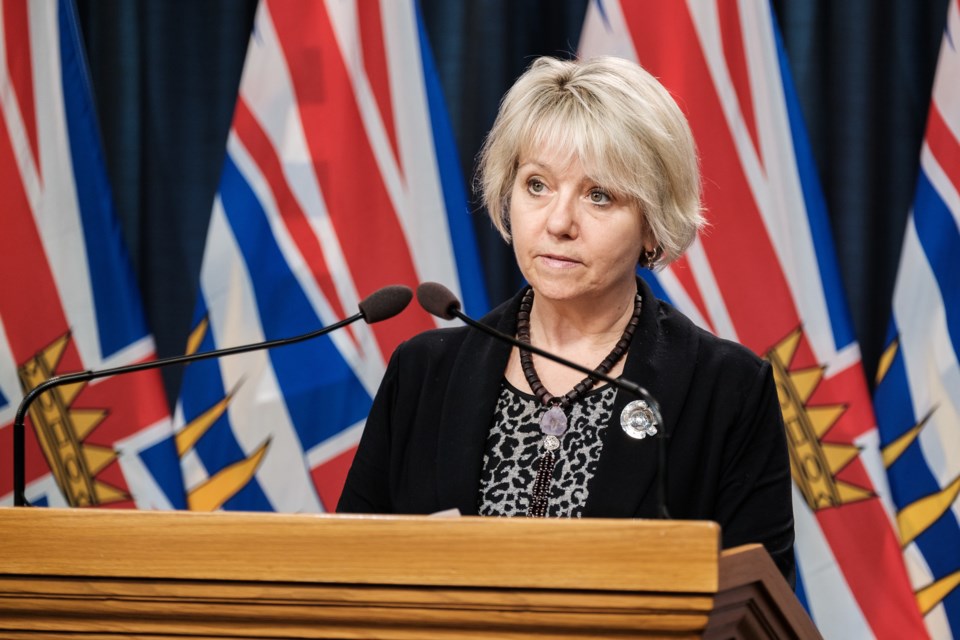B.C.'s COVID-19 curve continues to bend the wrong way.
In a written statement this afternoon (April 7), Provincial Health Officer Dr. Bonnie Henry said 997 more tests came back positive for the virus across B.C. during the past 24 hours for a new grand total of 106,985.
Of those infections, Northern Health added 18, raising the authority total to 6,312 since March of 2020.
Prov. total - 106,985
— Jess Balzer (@jessicajbalzer) April 7, 2021
New Northern Health, region total - 18/6,312
Active B.C. - 8,728
Public health monitoring prov. - 14,602
Hospital B.C. - 330
ICU B.C. - 105
New deaths, total B.C. - 2/1,491#bcpoli #covidbc #covid19bc #covid19 #bced #cdnpoli #cityofpg @PGMatters
There have been two new COVID-linked deaths, which raises the province's toll to 1,491.
There are 330 people in hospital, 105 of which are admitted in ICU or critical care.
There are 484 (14,602) more people under active public health monitoring than yesterday (14,118). #bcpoli #covidbc #covid19bc #covid19 #bced #cdnpoli #cityofpg @PGMatters
— Jess Balzer (@jessicajbalzer) April 7, 2021
It's also not good news in the north when it comes to positivity rates.
According to new data from the BC Centre for Disease Control (BCCDC), Northern Health's seven-day moving average positivity rate sits at 14.3 per cent.
The authority used to be the only area in B.C. in double digits, but now two other authorities, and the overall provincial rate, are in the same category.
Fraser Health comes in at 12 per cent while Vancouver Coastal Health has a rate of 11.3 per cent.
Interior Health and Island Health both remain in single digits, sitting at 6.6 per cent and 5.7 per cent respectively.
The seven-day moving average for B.C. is 10.2 per cent.
Restrictions remain in place throughout the province until April 19, including indoor dining at all food and liquor-serving restaurants paused. Outdoor patio dining, take-out and delivery services are still allowed.
Included in the amendment, Dr. Henry announced a halt on indoor adult group fitness activities, but individual or one-on-one activities may still take place, also noting that these kinds of settings 'amplify' the spread of COVID-19.
"It's with a heavy heart that I say this, but I can not in all conscious, with the increase number of cases we're having, [...] allow these types of activities to happen right now," Henry said on March 30.
She says travel throughout B.C. must now be essential for medical or work-related reasons only.
"Social connection is important, and so is keeping our loved ones and ourselves safe.
"We all have a choice – to stay safe or put our loved ones, our friends and ourselves at risk, which is why non-essential activities need to be limited and need to be outside with the same small number of people. The sacrifices we make today will help all of us to get through this storm."
In education, up-to-date list of northern B.C. schools marked for a COVID-19 exposure event in the month of April, and listed with a self-monitoring period, is as follows:
- Dawson Creek Secondary School, South Peace Campus (SD59) - March 29, 2021
- Lax Kxeen Elementary (SD52) - Marh 29-30, 2021
- Duncan Cran Elementary (SD60) - March 29-30, 2021
- Devereaux Elementary (SD59) - March 29, 2021
- Dawson Creek Secondary School (SD59) - March 31, 2021
- Ecole Frank Ross Elementary (SD59) - March 29, 2021
In all instances, Northern Health's school-exposure section explains the following:
- Contact tracing is initiated to determine how the individual was infected and who they were in close contact with
- We identify and notify close contacts who may be at an increased risk, and advise them to self-isolate and monitor for symptoms for 14 days
- Only Public Health can determine who is a close contact
- Learning groups, friends or other connections may not be determined to be a close contact
- Public Health staff works closely with the school and school district throughout the case and contact management process to maintain close communication with the school community


